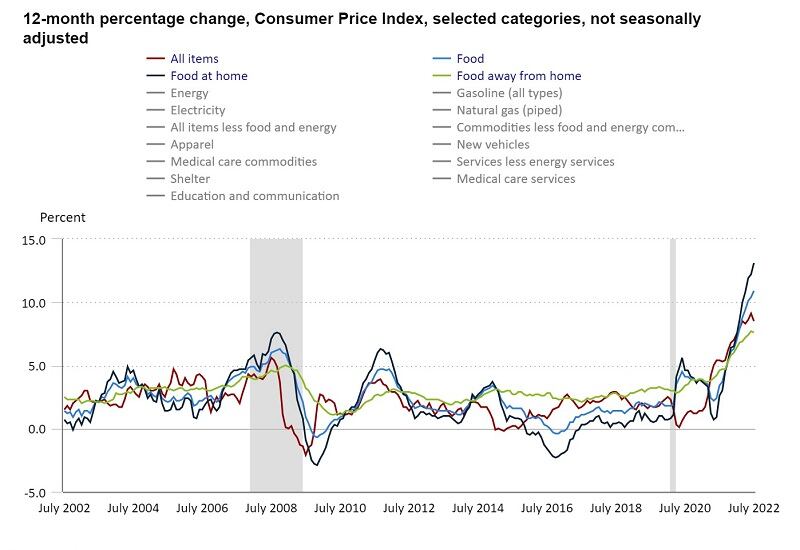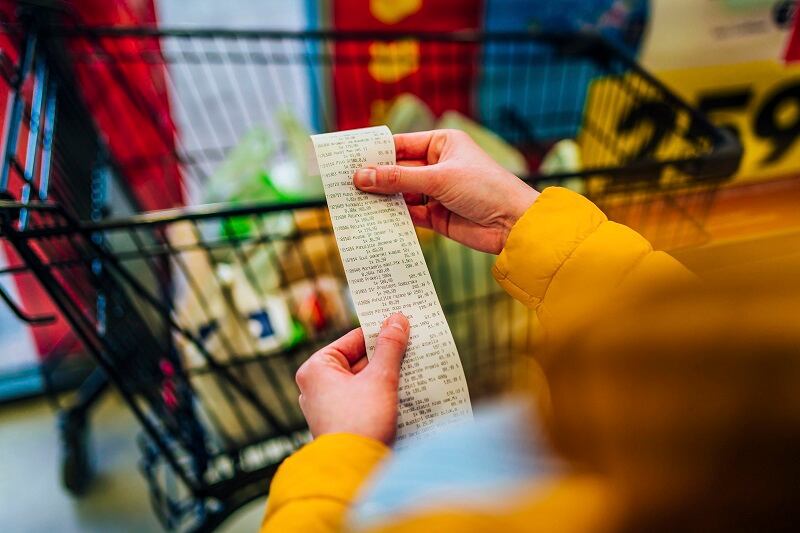Food prices increased 10.9% year-over-year in July, marking the largest 12-month surge since May 1979, according to the Bureau of Labor Statistics’ Consumer Price Index released yesterday. This includes a 1.1% increase over June and was the seventh consecutive monthly increase of 0.9% or more.
As in all prior months this year, the price of food consumed at home outpaced that of food away from home, up 13.1% in July 2022 vs July 2021.
The lift was driven by increases across all six major grocery store food groups, which was led by a 2.3% increase in non-alcoholic beverages, including a 3.5% increase in coffee, followed by a 1.8% month-over-month increase in cereals and bakery products.
The jump in food prices was counterbalanced by a broad 4.6% decline in energy prices, including a 7.7% drop in gasoline and a 11% drop in fuel oil. Electricity, however, ticked up 1.6%
This offset kept the overall CPI unchanged in July on a seasonally adjusted basis after increasing 1.3% in June, and slowed the all-items increase to 8.5% year-over-year before seasonal adjustment, according to BLS.
Many economists viewed this overall flattening positively, especially as it came in under expectations of economists surveyed by Dow Jones, which predicted the CPI would increase 8.7% year-over-year and 0.2% month-over-month.
And there are positive take-aways from the number, including a 0.5% monthly increase in “real wages,” and the suggestion the recent record-high interest rate hikes by the Fed may be having their intended effect and could reduce the need for a similarly high 0.75% interest hike in the near future.
Indeed Chicago Fed President noted at an event at Drake University in Des Moines, Iowa, yesterday that the data was “positive,” but he added it is still a “big number,” and “unacceptably” high. As such, he said, the Fed likely will continue to raise rates to 3.25% to 3.5% this year and as high as 4% by the end of next year.
Consumers are taking matters into their own hands
In the face of steadily rising food prices, consumers who for so long have appeared unfazed in their spending are finally beginning to feel the pinch and adjust their shopping habits.
According to Mintel, the percentage of consumers who describe their current financial situation as “healthy” began to dip in early June after holding relatively steady since the beginning of March. Likewise, the percentage of consumers who described their situation as “tight” is starting to creep up, as is the portion who report they are struggling, Lynn Dornblaser, director of innovation and insight at Mintel, told FoodNavigator-USA.
To compensate, she noted, about one in five consumers say they are switching to less expensive alternatives, such as private label products and frozen or canned food, and 29% say they plan to shop more at lower-cost retailers, according to a Mintel survey conducted in May.
Dornblaser noted that lower-income households are feeling inflationary pressures the most.
Manufacturers are responding with more flexibility
Several manufacturers and retailers have flagged low-income consumers, who collectively wield significant economic power, as a group to help by lowering opening prices points and increasing value propositions.
Tyson Foods is among the manufacturers pivoting to provide more value options as consumers try to make their grocery dollars stretch farther. During the company’s third-quarter earnings this week CEO Donnie King reported that the volume of more expensive cuts of beef and pork fell 1.5% and 2.1% respectively in the three months ending July 2, while the volume and sales for less expensive chicken are up 0.7% and 25% year-to-date.
TreeHouse Foods also reported this week that private label share gains continue to accelerate, helping to drive up its sales 19.4% to $1.198b in its second quarter.
Store brand gains are not concentrated to the hardest hit segments, but rather are across categories. According to data from the insights firm Catalina, sales of private label baking mixes are up 40%, soup 17%, prepared foods 12% and canned fish 10%.




